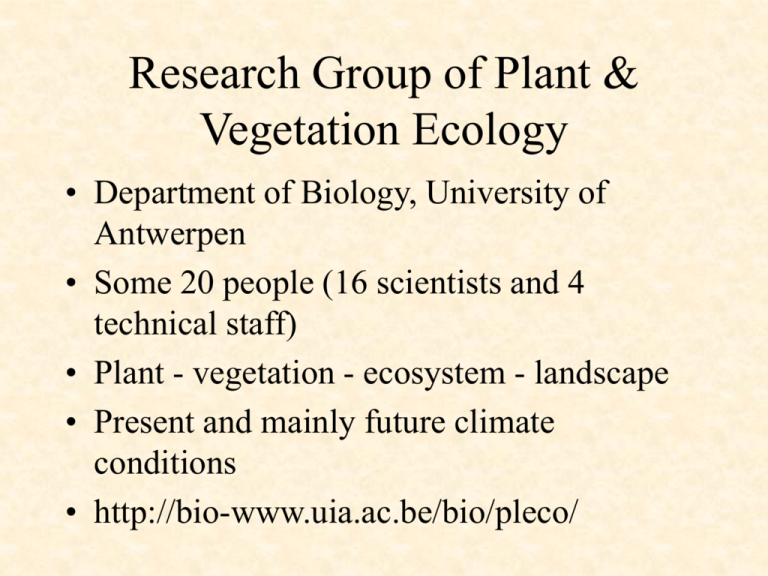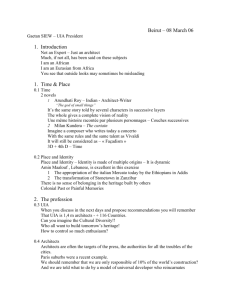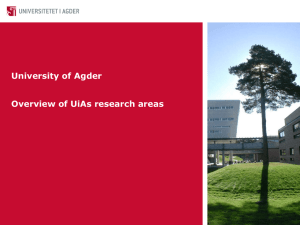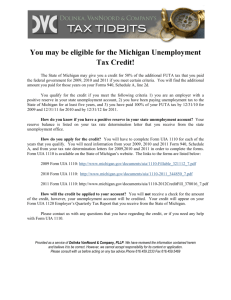University of Antwerpen UIA Prof. R. Ceulemans and Dr. G
advertisement

Research Group of Plant & Vegetation Ecology • Department of Biology, University of Antwerpen • Some 20 people (16 scientists and 4 technical staff) • Plant - vegetation - ecosystem - landscape • Present and mainly future climate conditions • http://bio-www.uia.ac.be/bio/pleco/ Research Group PLECO, UA (ctd.) • Experience with EC projects (Ecocraft, Euroflux & CarboEuroflux, Popface, Mefyque, ……) • Experience with modelling (poplar, Scots pine, process-based, mechanistic, Mefyque) • Some experience with data bases (Ecocraft & Euroflux) University of Antwerpen UIA Prof. R. Ceulemans and Dr. G. Deckmyn • Objectives / Deliverables – Creation and maintenance of a database – Further development of a mechanistic model and inclusion of ozone effects Database • • • • Access database (Microsoft) List of data and data sets available: YOU Templates to include data: us Data to be delivered by you in Excel spreadsheets according to template • Both raw data and averages + STD !? Database • Parameter values which have been derived from data according to an agreed set of equations or protocols. • Meta-data about the experiments and about the parameter values. • Implemented in Microsoft Access 97 or Access 2000. One of these programs is required, but proficiency in Access is not required. Database • Include date, time (when relevant), frequency of measurements, position in crown, age of leaf or tree, ozone treatment, ….. • Units (SI !) and predefined • Include all your parameters and variables ? • Or only those needed in the modelling exercise ? Experiment Table Experiment Name Site Name Latitude Longitude Species Provenance Institution Type of experiment Description of chamber / forest stand Rooting volume Start date End date Age of plants at start of treatment Pretreatment of plants Source of plants Pests or diseases, and treatment Soil type Watering regime Fertilization regime Average daily max temperature (growing season) Average daily min temperature (growing season) Average annual precipitation Operator Reference Treatment Conditions No. of replicates for each treatment Other Notes Database (ctd.) • Climatological variables and ozone • All parameters and variables ? • What with parameters/variables necessary for the modelling, but not measured ? • Strict rules and policies • Availability ? Restrictions of data ? • Who will put on the www ? Coordinator • http://www.ierm.ed.ac.uk/ecocraft/database page.html Modelling • Whole-tree and stand level modelling • Including ozone effects on various or all processes • Scaling and integration University of Antwerpen UIA Prof. R. Ceulemans and Dr. G. Deckmyn The model – Mechanistic – Forest scale, different species, including management, competition, wood quality – Modular: • • • • • • • photosynthesis (Farquhar) light (new code) climate (weather generator or data) soil (Thornley) water (ETP) allocation (new code) management (to be done) – Current state: nearly running, no ozone effects University of Antwerpen UIA Prof. R. Ceulemans and Dr. G. Deckmyn Rainfall Interception Canopy Evaporation Precip Climate Humidity ETp Soil-water input Temp Soil Evaporation Stomatal Control Radiation Transpiration Light interception Photosynthesis Photosyn params Plant/Stand Properties Carbon Gain/ Loss Tree Allocation Litter production Standing biomass Respiration Stem Allocation Architecture Physiological Control Water retention Soil Properties Soil C, N Fluxes C, N pools Wood Quality University of Antwerpen UIA Prof. R. Ceulemans and Dr. G. Deckmyn Strong points of the model – – – – allocation includes wood development interaction between trees data base for input values: soils, climate and species mechanistic but reasonable number of parameters University of Antwerpen UIA Prof. R. Ceulemans and Dr. G. Deckmyn Allocation module – Functional balance = relationship between leaf area, sapwood area and fine root biomass – Refinement of the functional balance: in stead of sapwood area use actual vessel/pipe data: flow depends on radius and number of active vessels in the sapwood – Detailed phasing of the alocation procedures allows differentiation between early wood and latewood – Pipe/vessel functionality is lost as a function of random embolition as well as death of associated leaves/needles – as a result, water movement through the tree is described in function of stomatal conductance, width and number of pipes in branches and stem and soil water potential. University of Antwerpen UIA Prof. R. Ceulemans and Dr. G. Deckmyn Allocation module – Depending on the growing phase (trigerred by tree development, temperature and soil water potential) trees allocate carbon – Phase 1: refill existing crown, formation of new pipes (stemwidth) – Phase 2: new height and crown with associated leaves, branches, roots and stemwidth – phase 3: latewood, cessation of height growth and start of storage of C for spring regrowth – Phase 4: autumn leaf fall, depends on functionality of the leaves University of Antwerpen UIA Prof. R. Ceulemans and Dr. G. Deckmyn Live branches Fallen branches Knot free University of Antwerpen UIA Prof. R. Ceulemans and Dr. G. Deckmyn latewood heartwood earlywood University of Antwerpen UIA Prof. R. Ceulemans and Dr. G. Deckmyn Necessary changes and additions • General model – Debugging and validation of new code (allocation and light) – include management: thinning, rotation period,… – improve interface input/output – validate for European forests – validate weather generator outside UK University of Antwerpen UIA Prof. R. Ceulemans and Dr. G. Deckmyn Necessary Changes and additions • Ozone effects – Include ozone input, possibly through weather module, including shade versus sunlit crown – Improve stomatal modelling: currently Ball-Berry, needs more detailed mechanistic modelling based on recent papers and new data – Include mycorrhizae – Include effects on photosynthesis – Include effects on allocation – Include effects on phasing University of Antwerpen UIA Prof. R. Ceulemans and Dr. G. Deckmyn Necessary Input – New data and publications on: • • • • • • • • stomatal effects Vcmax, Jmax Rhizomes allocation: R/S, SLA, LAR Stemwood??? Biomass Soil processes respiration University of Antwerpen UIA Prof. R. Ceulemans and Dr. G. Deckmyn Timing • Model Improvements and Validation – 2003 • Ozone effects – 2004 • Final validation and output – Jan to Octobre 2005







